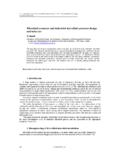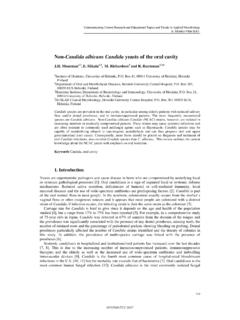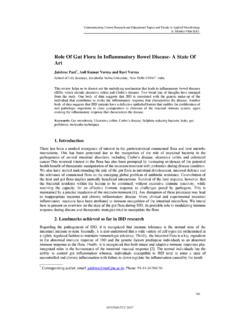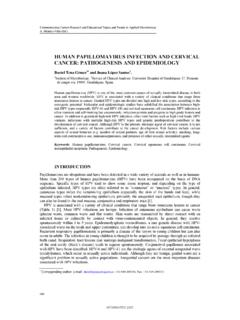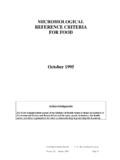Transcription of Microbiological quality of commercial dairy products
1 Microbiological quality of commercial dairy products L szl Varga* Department of dairy Science, Institute of Food Science, Faculty of Agricultural and Food Sciences, University of West Hungary, 15-17 Lucsony Street, 9200 Mosonmagyar v r, Hungary The purpose of this research was to assess the hygienic properties of commercially available dairy foods. The products surveyed included liquid milks (pasteurized and UHT-treated), cultured dairy products (kefir, cultured buttermilk, sour cream, yogurt, probiotic fermented milks), cheeses (quarg products , soft, semi-hard, hard, and extra hard cheeses made from bovine, caprine, and ovine milk), processed cheeses, butters, butter creams, dried milks, and ice creams.
2 A total of 320 samples were purchased from food stores located in the western part of Hungary. Upon collection, all products were taken to the laboratory and were stored as required until analysis. Although none of the samples tested contained Salmonella spp. or Listeria monocytogens, approximately 14% of them failed to meet the legal requirements in terms of overall hygienic quality . The share of non-compliant samples was especially high among cheeses. Keywords hygienic quality ; dairy food 1. Introduction Food spoilage is an enormous economic problem worldwide. Through microbial activity alone, approximately one-fourth of the world s food supply is lost [1]. Milk is a highly nutritious food that serves as an excellent growth medium for a wide range of microorganisms [2, 3].
3 The Microbiological quality of milk and dairy products is influenced by the initial flora of raw milk, the processing conditions, and post-heat treatment contamination [4]. Undesirable microbes that can cause spoilage of dairy products include Gram-negative psychrotrophs, coliforms, lactic acid bacteria, yeasts, and molds. In addition, various bacteria of public health concern such as Salmonella spp., Listeria monocytogenes, Campylobacter jejuni, Yersinia enterocolitica, pathogenic strains of Escherichia coli and enterotoxigenic strains of Staphylococcus aureus may also be found in milk and dairy products [5]. For this reason, increased emphasis should be placed on the Microbiological examination of milk and dairy foods.
4 Microbiological analyses are critical for the assessment of quality and safety, conformation with standards and specifications, and regulatory compliance [6]. In Hungary, a very comprehensive set of Microbiological reference criteria covering virtually all foods and including limits for an extensive range of indicators and pathogens was issued by the Ministry of Health in 1998. This official document entitled Decree No. 4/1998 (XI. 11.) E M on the acceptable levels of Microbiological contamination in foods [7] is based on ICMSF and FAO principles in that it includes sampling plans and identifies the criteria for acceptance or rejection of a lot. Altogether 26 food groups have mandatory criteria and the number or type of microorganisms for which there are limits for any particular food varies from one to nine.
5 Divided into nine subgroups, milk and milk products constitute one of the 26 groups formed. As of 2003, in terms of dairy foods, this legal document was replaced by another one titled Decree No. 1/2003 (I. 8.) FVM-ESzCsM on the food hygienic conditions for production and placing on the market of raw milk, heat-treated milk and milk-based products [8], which is identical in content with the EU Milk Hygiene Directive 92/46/EEC [9]. In the international literature, there is a relative scarcity of data pertaining to the levels of spoilage organisms and pathogens in commercially available milk products . Therefore, the aim of this study was to monitor the hygienic quality of milk and dairy foods sold to the general public in Hungary.
6 * Corresponding author: e-mail: Communicating Current Research and Educational Topics and Trends in Applied Microbiology A. M ndez-Vilas (Ed.)487 FORMATEX 2007_____ 2. Materials and Methods Table 1 Microbiological reference criteria for dairy foods in Hungary. n c m M n c m M Product Microorganism (group) Before 2003 [7] As of 2003 [8] Salmonella spp. 5 0 0/25g 5 0 0/25g Listeria monocytogenes 5 0 0/25g 5 0 0 Staphylococcus aureus 5 2 1 10 Enterococcus faecalis 5 2 10 102 Coliforms 5 1 1 10 5 2 1 5 Pasteurized milk Total plate count 5 2 104 105 5 2 104 105 UHT milk Total plate count 5 0 0 1 0 10 Salmonella spp.
7 10 0 0/25g 5 0 0/25g Listeria monocytogenes 5 0 0 Staphylococcus aureus 5 2 1 10 Cultured dairy producta Molds 5 2 102 103 Salmonella spp. 5 0 0/25g 5 0 0/25g Listeria monocytogenes 5 0 0/25g 5 0 0/25gb Staphylococcus aureus 5 0 0 5 2 103/102/10c 104/103/102c Escherichia coli 5 2 104/102/ c 105/103/ c Coliforms 5 2 10d 102d 5 2 /104/ c /105/ c Sulfite-reducing clostridia 5 1 10 102 Cheese Molds 5 1 10 102
8 Salmonella spp. 5 0 0/25g 5 0 0/25g Listeria monocytogenes 5 0 0 Staphylococcus aureus 5 0 0 Processed cheese Total plate count 5 2 104 105 Salmonella spp. 5 0 0/25g 5 0 0/25g Listeria monocytogenes 5 0 0 5 0 0 Butter and butter product Coliforms 5 2 1 10 Salmonella spp. 10 0 0/25g 10 0 0/25g Listeria monocytogenes 5 0 0/25g 5 0 0 Staphylococcus aureus 10 2 1 10 5 2 10 102 Coliforms 5 2 1 10 5 2 1 10 Dried milk Total plate count 5 2 104 105 Salmonella spp.
9 10 0 0/25g 5 0 0/25g Listeria monocytogenes 5 0 0 Staphylococcus aureus 5 1 102 103 5 2 10 102 Escherichia coli 5 1 10 102 Coliforms 5 2 10 102 Ice cream Total plate count 5 2 105 105 n: The number of sample units to be examined from a lot of dairy food; c: The maximum allowable number of marginally acceptable sample units; m: Expressed in CFU/g, it represents an acceptable level and values above it are marginally acceptable or unacceptable in terms of the sampling plan; M: Expressed in CFU/g unless otherwise stated, it is a Microbiological criterion which separates marginally acceptable quality from defective quality .
10 A According to regulatory criteria in effect before 2003 [7], quarg and quarg products belonged to this group of dairy foods; b Not applicable to hard cheese, for which M = 0 CFU/g; c Cheese made from raw milk or thermized milk / Soft cheese made from heat treated milk / Fresh cheese; d For soft cheese m = 104 and M = 105. Communicating Current Research and Educational Topics and Trends in Applied Microbiology A. M ndez-Vilas (Ed.)488 FORMATEX 2007_____ From 2001 through 2006, a total of 320 samples of milk products were purchased from food stores located in the western part of Hungary. Duplicate ( , two identical) samples were collected from each type of product at each sampling session. Either of them was examined right after purchase whereas the other one was stored at the required temperature and analyzed immediately before the end of shelf life.
